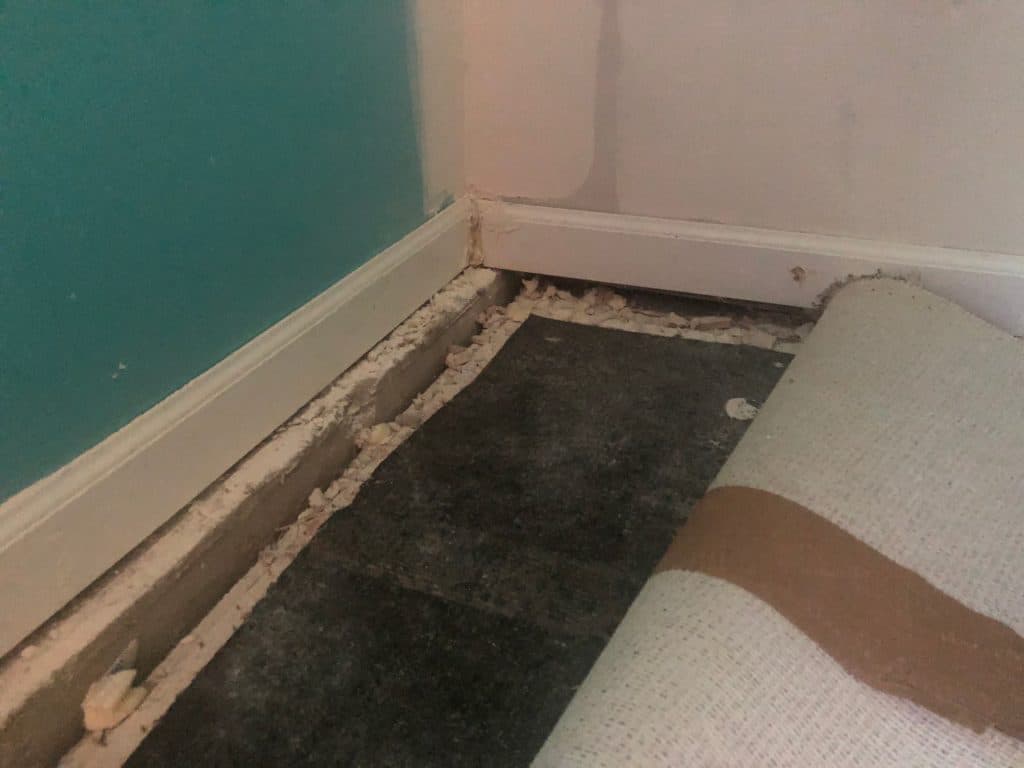
Slab foundations are relatively common, here in the Midwest. If your home doesn’t have a basement or crawl space built under it? It’s a slab foundation home. Basements and crawl spaces both require a substantial excavation at the beginning of the project; since slab foundations are shallow, they don’t take as much preparation. That makes them faster and easier to construct, and they’re often less expensive to maintain.
But no style of home is perfect, or immune to the whims of Mother Nature. All homes will settle to varying degrees; the weight of the house puts pressure on the ground, and the soil shifts to accommodate it. Acculevel is very familiar with how all types of foundations settle, and the best methods to repair them. Since our start in 1996, we’ve helped more than 35,000 homeowners restore strength and stability to their homes, and we want to do the same for you.
In this blog, we’re going to detail the differences between a monolithic slab vs traditional slab. We’ll explain how these variations can complicate diagnosis, and the best repair method for a settling monolithic slab foundation.
A footer (or a footing) is a large piece of concrete- sometimes reinforced with iron rebar- that is poured around the outside perimeter of a home. Once it’s completely set, the foundation is built on top of that footer.
Footers are important because they help to stabilize your home- especially if you’re going to have a basement or crawl space. Instead of having all the weight of your home resting on narrow walls (the average concrete block is 8 inches wide), the weight of your home is spread out across a wider footing of 16-24 inches.
The best comparison I can think of is a dining chair with standard legs versus one with a sled base. When you sit on the standard chair, your weight is divided among 4 narrow points at the end of the legs. When you sit in a chair with a sled base, your weight is spread out across a longer base. Which chair is going to dent a soft surface first?
All this talk of footers may seem like a waste of your time and attention, but there’s a reason we’ve dug into this subject. For most homes, the footer is created first, then the foundation is built on top of it.
For a monolithic slab foundation, the footer and the foundation are all created together, as one solid piece.

This simplified illustration was created by the author
Settling is our industry’s term for sinking into the ground. As we covered at the beginning, all homes settle. The problems begin when a home settles unevenly. Maybe the ground is eroded along one side of the house, or the soil density isn’t consistent across the entire property. Whatever the cause may be (we fully cover causes and symptoms here), the effect is that your home is strained by uneven movement.
Homes are built to hold their shape. They are not flexible, and if one part is moving away from the rest, you’re going to see signs of trouble. As the wood, concrete, and drywall are pulled and “stretched,” cracks start to form, because these materials cannot actually stretch. So you’ll see cracks in the walls or ceiling, doors that don’t swing easily on their hinges, or windows that slam shut if you don’t prop them open.
If you have settling in a typical slab foundation, we need to determine which component of your foundation needs repairing. We can use helical piers to raise the outside of the foundation OR we can slabjack the inside floor of the foundation.
The best repair method for a settling foundation is helical piers. These are long steel posts that are installed in the earth until they reach stable soil (determined by pressure gauge). These posts are then bracketed against the foundation’s footer to hold the foundation in place.

This is an illustration of a helical pier.
Depending on the situation and the homeowners’ preference, the piers may be able to lift the settling section back into place.
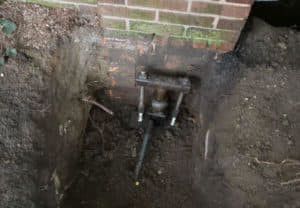
This photo was taken by an Acculevel crew member while installing helical piers at a customer’s home. Under the brick facade, there is a concrete foundation with footer.
When a slab foundation settles in the center of your home (or more than a few feet away from the outside wall), the best repair method is going to be concrete leveling. Acculevel provides a service called slabjacking. Like mudjacking, it requires small holes drilled through your slab. The fill material is injected to lift the slab back into place. You can read about both concrete leveling methods or watch the video below to learn more.
In the photos below, you can see how slabjacking has lifted the floor of this bedroom. The first picture was taken by an Acculevel project advisor during a home consultation; the second was taken by a crew member after slabjacking was completed.
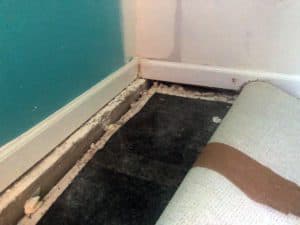 |
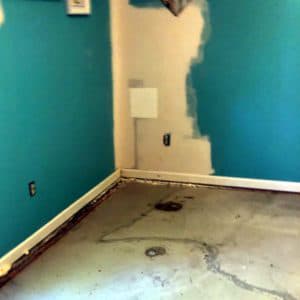 |
To summarize: when we repair settling in a typical slab foundation, we have to determine first if you need piers to raise the outside of the foundation OR if you need the inside foundation slabjacked.
If your home has a monolithic slab foundation that is settling, you will need BOTH piers and slabjacking.
Not sure why this is the case? Let’s say the perimeter of your foundation is settling in one corner. We will need to install piers under the footer to lift it. But once we move that portion of the foundation, what happens to the rest of it? Remember- the entire foundation is one solid piece.
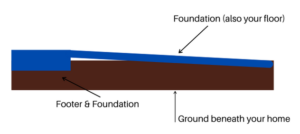
It’s still a simplified illustration of your foundation, but having a visual does help.
That pier will create a gap under your floor. If we don’t fill that gap, over time the foundation could crack, destabilizing your home. Using a concrete leveling method to fill the gap will add the needed support to the floor.
The reverse is also true. If the floor in your home is settling, we need to lift it with a concrete leveling method like slabjacking. And if we only lift the interior of the foundation, it will strain the foundation where it connects to the exterior with the footer. Helical piers will stabilize the footer end of the foundation, keeping your foundation secure.
Have you noticed other signs of foundation trouble? Need more information about piers? Want to know about repair costs? We cover all of that- and more- in our Guide to Foundation Repair. This is a free resource that we update regularly, and it answers all of the most common questions we hear from homeowners like you.
If you live in Indiana or the surrounding areas, you’re within our service area! Give us a call at 866-669-3349, or fill out our online form. We’ll schedule an in-home consultation with one of our expert project advisors. They will meet with you, address all of your concerns, then evaluate your home. Once they’ve completed our detailed home checklist, they’ll help you develop a whole-home solution that solves any problems they’ve diagnosed.
Do you live outside of our service area? You’ll need to find a local contractor to help you with your home repairs. We recommend you check with friends or neighbors who have experienced similar problems; you need a company with a good reputation, great reviews, and is accredited by the Better Business Bureau.
[DISPLAY_ULTIMATE_SOCIAL_ICONS]